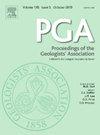从地表和地下资料对突尼斯东北部新近系至更新世构造-沉积重大事件的新认识
IF 1.3
4区 地球科学
Q2 Earth and Planetary Sciences
引用次数: 0
摘要
本研究的主要目的是分析突尼斯东北部地表和地下新近系至新近系岩石的结构,以识别露头中的不整合面,并在地下数据中检测这些构造和沉积事件。通过编制新露头资料、地震反射剖面和油井资料,对研究区构造演化进行了综合研究。该研究提高了人们对新近纪至更新世突尼斯东北部地质演化的认识。该区划分出托尔顿不整合、墨西尼亚不整合、上新世不整合和中更新世不整合四大不整合面。不整合面填图表明,这些不整合面与晚中新世至今的一次大反转事件有关,导致地层发育受构造因素控制。通过对19个地震剖面的分析,证实了与挤压和压迫构造事件有关的几个特征的存在。这些包括逆断层、褶皱和不整合面。这些不整合面的构造填图揭示了一个主导断裂系统的存在,该系统包围了大量中等规模的盆地。本文章由计算机程序翻译,如有差异,请以英文原文为准。
New insights into Neogene to Pleistocene tectono-sedimentary major events in northeastern Tunisia from surface and subsurface data
The main objective of this study is to analyse the structure of the Neogene to Recent rocks in the surface and subsurface of northeastern Tunisia, in order to identify unconformities in outcrops and detect these tectonic and sedimentary events in the subsurface data.
An integrated study of multi-data supported by the compilation of new outcrop data, seismic reflection profiles, and data from petroleum wells has been carried out in order to determine the structural evolution in the study area. This study has resulted in an improved understanding of the geological evolution of NE Tunisia during the Neogene to Pleistocene. Four major unconformities have been identified in this area, the Tortonian unconformity, the Messinian unconformity, the Pliocene unconformity and the mid-Pleistocene unconformity.
The mapping of unconformities indicates their association with a major inversion event that occurred from the Late Miocene to the present, resulting in the development of stratigraphy controlled by structural factors. The analysis of nineteen seismic sections has confirmed the existence of several features associated with compressive and transpressive tectonic events.
These include reverse faults, folds, and unconformities. The structural mapping of these unconformities reveals the presence of a dominant fault system bounding a large number of moderate sized basins.
求助全文
通过发布文献求助,成功后即可免费获取论文全文。
去求助
来源期刊
CiteScore
2.70
自引率
8.30%
发文量
54
审稿时长
6-12 weeks
期刊介绍:
The Proceedings of the Geologists'' Association is an international geoscience journal that was founded in 1859 and publishes research and review papers on all aspects of Earth Science. In particular, papers will focus on the geology of northwestern Europe and the Mediterranean, including both the onshore and offshore record. Following a long tradition, the PGA will focus on: i) a range of article types (see below) on topics of wide relevance to Earth Sciences ii) papers on aspects of Earth Science that have societal relevance including geoconservation and Earth management, iii) papers on palaeoenvironments and palaeontology of the Mesozoic and Cenozoic, iv) papers on aspects of Quaternary geology and climate change, and v) papers on the history of geology with particular reference to individuals that have shaped the subject. These topics will also steer the content of the themes of the Special Issues that are published in the PGA.

 求助内容:
求助内容: 应助结果提醒方式:
应助结果提醒方式:


